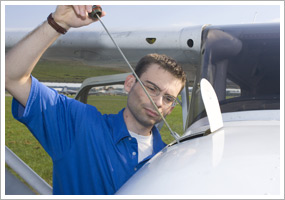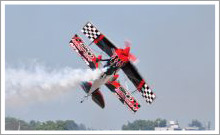| ||||
| | FT News | INSIDE AOPA | TRAINING PRODUCTS | FINAL EXAM | |||
Attention reader: What do you think of ePilot Flight Training Edition? Tell us in this short survey! TRAINING TIPs Hot oil Another risk is an overheated engine. That reduced performance probably means a longer time climbing to cruise altitude, at a climb angle of attack that, even in ideal conditions, provides less than maximum air flow over the cylinders. Add in some pretakeoff delay, or prolonged taxiing, and it is time to be watchful for a higher-than-usual oil temperature indication. If such an indication appears during the climb, try a tradeoff: Increasing your airspeed will improve engine cooling but sacrifice some climb performance. Check the mixture—do you remember which condition can result in excessive temperatures? Engine temperature management is a balancing act. Unusual outside air temperatures make it a more complicated puzzle to solve. “Keeping an engine too cool in flight can also be harmful; if oil cannot get hot enough to burn off water that has condensed in it, internal engine rust can occur. Engine experts suggest an oil temperature of around 180 degrees or a little higher as a happy medium for typical air-cooled GA engines,” says the Air Safety Institute’s Engine Operations Safety Advisor. Note the publication’s advice about using other installed instruments such as an exhaust-gas temperature gauge or cylinder-head temperature gauge to help manage engine temperatures. If basic temperature-control methods aren’t working, you may have to shift to troubleshooting mode. Did you remember to check the oil during your preflight inspection? The problem could be as simple (but still serious) as low oil quantity. Symptoms and possible causes were discussed in an August 2002 Flight Training feature. Remember that a high oil temperature indication paired with low oil pressure signals serious engine problems. Land as soon as possible. Your answers on this Final Exam from a past issue of ePilot Flight Training Edition provide a good gauge of your knowledge of engine operations. Check your performance, and review as necessary before that next flight on a hot day. If you need a brushup, try the Air Safety Institute’s Engine and Propeller online course. YOUR PARTNER IN TRAININGIs a professional flying job in your future? Read “AOPA's Guide to Flying Careers,” written for people who envision themselves earning a living as a pilot, and learn about the possibilities.
Did you know that student pilots who join AOPA are three times more likely to complete their flight training? Membership includes unlimited access to aviation information by phone (800/USA-AOPA, weekdays from 8:30 a.m. to 6 p.m. Eastern time) or from Flight Training Online or AOPA Online. If you're not already a member, join today and get the pilot’s edge. Login information is available online. FLIGHT TRAINING NEWSUniversity of Illinois to close aviation programThe Board of Trustees of the University of Illinois voted 6-2 on July 21 to close a noted aviation program that has been turning out pilots for the airlines, industry, and government since 1946. The university’s Institute of Aviation will shut down at the end of the 2013-2014 academic year. However, Institute of Aviation Interim Director Tom W. Emanuel expressed hope that the institute might re-emerge, possibly in partnership with a community college as a “bridge program” that would offer credits at both academic levels. “We’re still fighting. We’re not giving up on this,” said Emanuel, noting that program graduates work for airlines, the FAA, and corporations such as Mitre and Boeing, where they use their human-factors education and aviation knowledge to design cockpits. Read more >> Flight training initiative holds meetingsA series of regional meetings that AOPA is hosting as part of its Flight Training Student Retention Initiative began in May and continues in August, as the aviation community works to increase the success of pilot trainees and address the decline of the pilot population. The team will visit Long Beach, Calif., and Chicago in August, and conclude the tour in Dallas in early September. Read more >> New course explores datalink weatherThe arrival of datalink weather in the cockpit has made some things better, but it hasn’t changed the fact that thunderstorms, icing, and low ceilings are as dangerous as ever. The Air Safety Institute’s newest course, IFR Insights: Cockpit Weather, is meant to help pilots avoid getting in over their heads. Part online course, part video, and part interactive scenario, it seeks to help instrument-rated pilots discover how to use datalink to complete more trips and minimize weather risks. Take the course >> Summer flight academy celebrates sixth yearThe North Valley Aviation Association (NVAA) in Chino, Calif., recently shepherded a group of high school students through a two-week summer flight academy for the sixth year in a row. The participants flew daily and attended ground school throughout the academy, and logged 10 hours in a Cessna 172. At the conclusion of the event, they were allowed to fly a Diamond DA20. Flight instruction and aircraft rental were provided by Air Carriage, a local flight school. The NVAA, a chapter of the California Pilots Association, estimates that it spends about $10,000 per year to sponsor the event. To learn more or make a donation, see the website. Inside AOPA‘Contact tower … good day …’If you’re gripping the yoke a bit tighter at the mere thought of landing at a towered airport, maybe now is a good time to review the Air Safety Institute’s Operations at Towered Airports Safety Advisor. Know what to expect so you don’t feel flustered: Review which clearances are required, what type of ATC instructions to expect, how to communicate, and how to navigate the often busy terminal environment. All it takes is being prepared. Download the Safety Advisor. Ownership for ‘average Joes’AOPA member Jeff Hancock says he is not rich and doesn’t live a lavish lifestyle. Yet his decision to purchase an airplane to augment his business activities turned out to be easier than he had expected, thanks to the assistance of AOPA’s financial and insurance services. Read more >> Member Products and your freedom to flyAOPA’s ability to provide a strong voice for general aviation relies on its members. Member engagement is vital to the association’s mission to protect GA, and purchasing AOPA Member Products plays a significant role in supporting that effort. Funding from AOPA Member Products has provided the means necessary for AOPA’s government affairs division to fight and win important GA issues for members—and all pilots. Read more >> TRAINING PRODUCTS‘Lesson Plans to Train Like You Fly’Arlynn McMahon, 2009 CFI of the Year, has followed up her successful Train Like You Fly textbook with Lesson Plans to Train Like You Fly, published by ASA. The book provides lesson plans in the form of “maneuver briefings,” and shows flight instructors what to draw and what to say to teach each maneuver required for the private and commercial certificates. Templates, checklists, and student assignments are included. The book sells for $19.95 or $14.99 in e-book format. For more information, see the website.
Note: Products listed have not been evaluated by ePilot editors unless otherwise noted. AOPA assumes no responsibility for products or services listed or for claims or actions by manufacturers or vendors. FINAL EXAMQuestion: Is a high-performance endorsement required to operate a turbine-powered airplane?
Answer: Assuming that an engine produces more than 200 horsepower, the answer to your question is yes. FAR 61.31(f) makes no distinction between types of engines for a high-performance aircraft. It merely states that in order to act as pilot in command (PIC) of an airplane with an engine of more than 200 hp, an individual must have received training from an authorized instructor in a high-performance airplane, or in a simulator or flight training device that is representative of a high-performance airplane, and obtain a logbook endorsement. There is an exception for those who had logged high-performance PIC flight time prior to Aug. 4, 1997. No training or endorsement is required for those folks. For more on flying high-performance aircraft, read AOPA’s subject report.
Got a question for our technical services staff? Email [email protected] or call the Pilot Information Center, 800/872-2672. Don’t forget the online archive of “Final Exam” questions and answers, searchable by keyword or topic. AOPA Career OpportunitiesEver dream of turning your passion for aviation into a career? We’re looking for an application support engineer, Dot Net developer, and electronic advertising manager. To learn more about other AOPA career opportunities, visit AOPA Online. Picture Perfect AVIATION EVENTS & WEATHER To include an event or to search all events in the calendar, visit AOPA Online. For airport details, including FBO fuel prices, see AOPA Airports. Flight Instructor Refresher ClinicsThe next Air Safety Institute Flight Instructor Refresher Clinics are scheduled in Atlanta, Ga., and Fort Worth, Texas, Aug. 6 and 7; Long Beach, Calif., and Allentown, Pa., Aug. 13 and 14; Champaign, Ill., and Reno, Nev., Aug. 20 and 21; and Phoenix, Ariz., and Bellevue, Wash., Sept. 10 and 11. For a complete schedule, see AOPA Online.
Can’t make it in person? Sign up for the CFI Refresher Online. Air Safety Institute Safety SeminarsAir Safety Institute Safety Seminars are scheduled in Wichita, Kan., Germantown, Tenn., and Houston, Texas, Sept. 12; Bethany, Okla., Nasvhille, Tenn., and San Antonio, Texas, Sept. 13; Fayetteville, Ark., Maryville, Tenn., and Austin, Texas, Sept. 14; and Little Rock, Ark., Sept. 15.
Topics vary—for details and a complete schedule, see AOPA Online. | Advertisers Got news? Contact ePilot. Having difficulty using this service? Visit the ePilot Frequently Asked Questions now at AOPA Online or write to [email protected]. |
| This issue of ePilot was created for &fname; &lname; at &*TO; Member Tools : Send feedback | ePilot Archive Editorial Team: ePilot Flight Training Editor : Jill W. Tallman | ePilot Editor: Sarah Brown | Contributor: Alton K. Marsh |

 Flying during a summer heat wave presents special challenges for the aircraft and the pilot. Every student pilot learns that loss of climb performance from
Flying during a summer heat wave presents special challenges for the aircraft and the pilot. Every student pilot learns that loss of climb performance from 


